engine RENAULT SCENIC 2008 J84 / 2.G Engine And Peripherals - Starting Charging Workshop Manual
[x] Cancel search | Manufacturer: RENAULT, Model Year: 2008, Model line: SCENIC, Model: RENAULT SCENIC 2008 J84 / 2.GPages: 21, PDF Size: 0.08 MB
Page 1 of 21
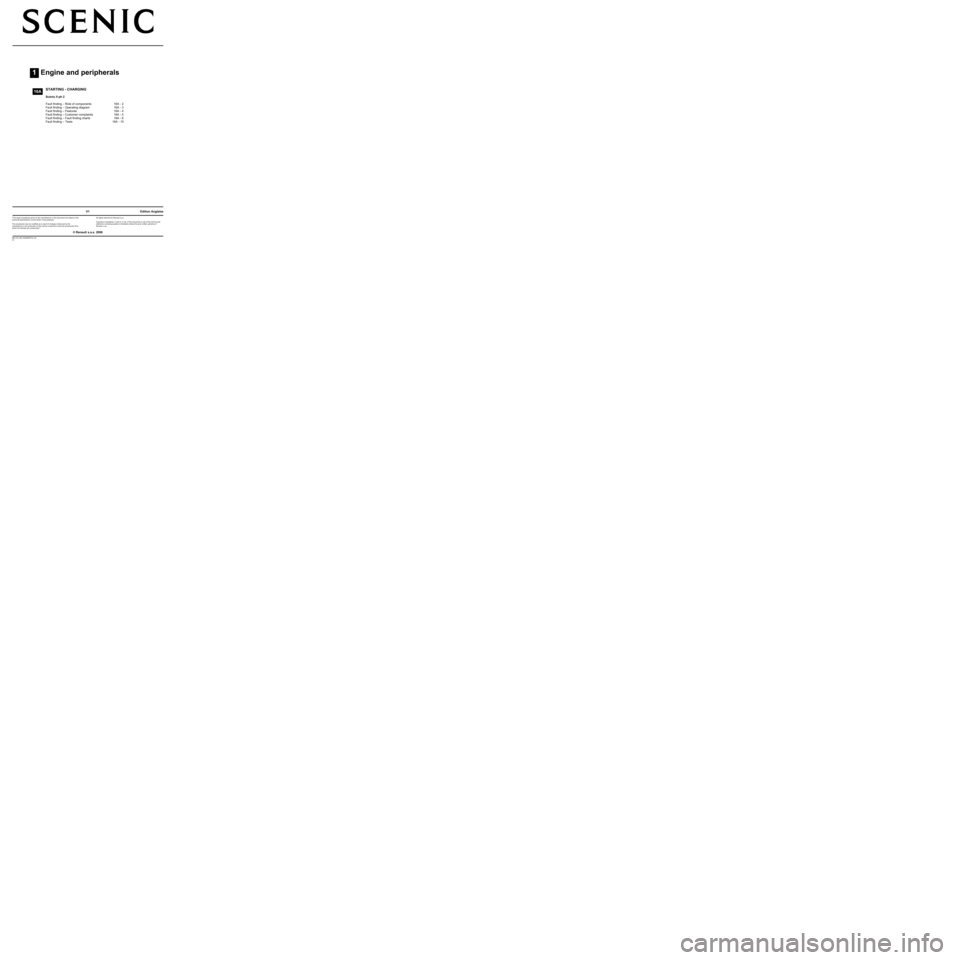
1Engine and peripherals
V1 MR-372-J84-16A000$TOC.mif
V1
16A
"The repair procedures given by the manufacturer in this document are based on the
technical specifications current when it was prepared.
The procedures may be modified as a result of changes introduced by the
manufacturer in the production of the various component units and accessories from
which his vehicles are constructed."
V1
All rights reserved by Renault s.a.s.
Edition Anglaise
Copying or translating, in part or in full, of this document or use of the service part
reference numbering system is forbidden without the prior written authority of
Renault s.a.s.
© Renault s.a.s. 2008
STARTING - CHARGING
Scénic II ph 2
Fault finding – Role of components 16A - 2
Fault finding – Operating diagram 16A - 3
Fault finding – Features 16A - 4
Fault finding – Customer complaints 16A - 5
Fault finding – Fault finding charts 16A - 6
Fault finding – Tests 16A - 15
Page 2 of 21
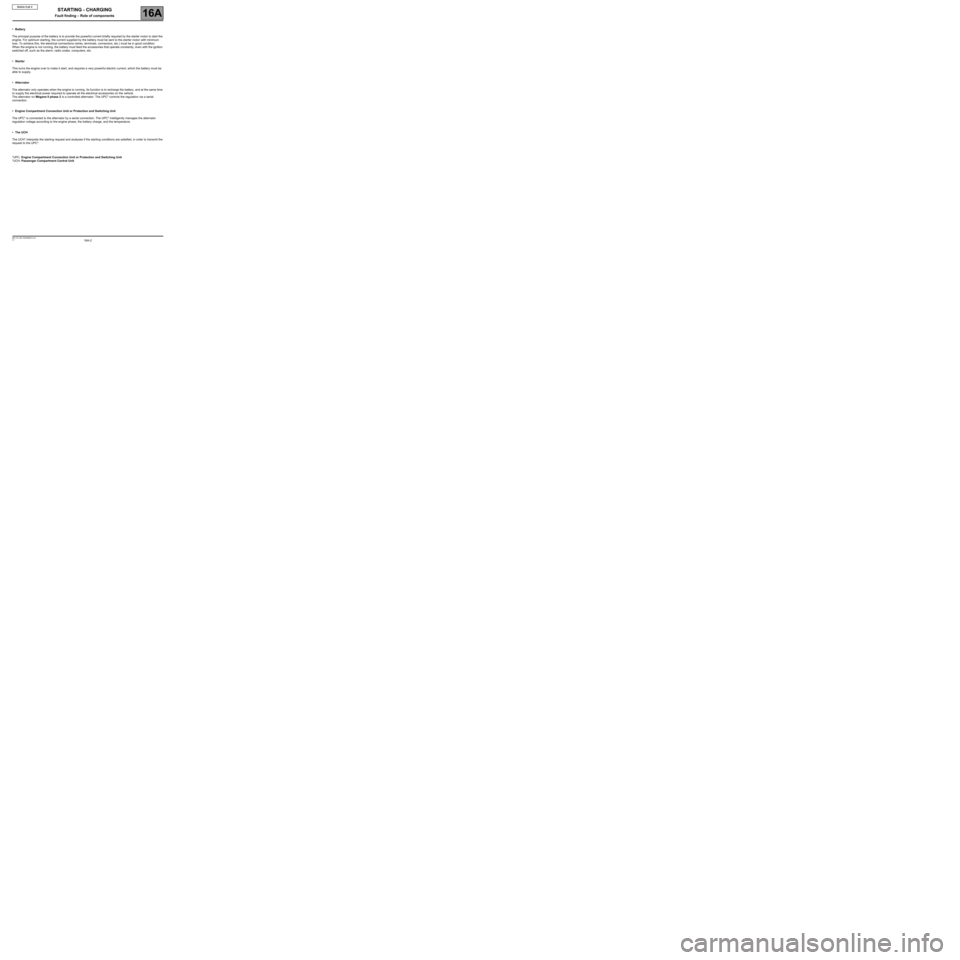
16A-2V1 MR-372-J84-16A000$010.mif
16A
Scénic II ph 2
•Battery
The principal purpose of the battery is to provide the powerful current briefly required by the starter motor to start the
engine. For optimum starting, the current supplied by the battery must be sent to the starter motor with minimum
loss. To achieve this, the electrical connections (wires, terminals, connectors, etc.) must be in good condition.
When the engine is not running, the battery must feed the accessories that operate constantly, even with the ignition
switched off, such as the alarm, radio codes, computers, etc.
•Starter
This turns the engine over to make it start, and requires a very powerful electric current, which the battery must be
able to supply.
•Alternator
The alternator only operates when the engine is running. Its function is to recharge the battery, and at the same time
to supply the electrical power required to operate all the electrical accessories on the vehicle.
The alternator on Mégane II phase 2 is a controlled alternator. The UPC* controls the regulation via a serial
connection.
•Engine Compartment Connection Unit or Protection and Switching Unit
The UPC* is connected to the alternator by a serial connection. The UPC* intelligently manages the alternator
regulation voltage according to the engine phase, the battery charge, and the temperature.
•The UCH
The UCH* interprets the starting request and analyses if the starting conditions are satisfied, in order to transmit the
request to the UPC*.
*UPC: Engine Compartment Connection Unit or Protection and Switching Unit
*UCH: Passenger Compartment Central Unit
STARTING - CHARGING
Fault finding – Role of components
Page 4 of 21
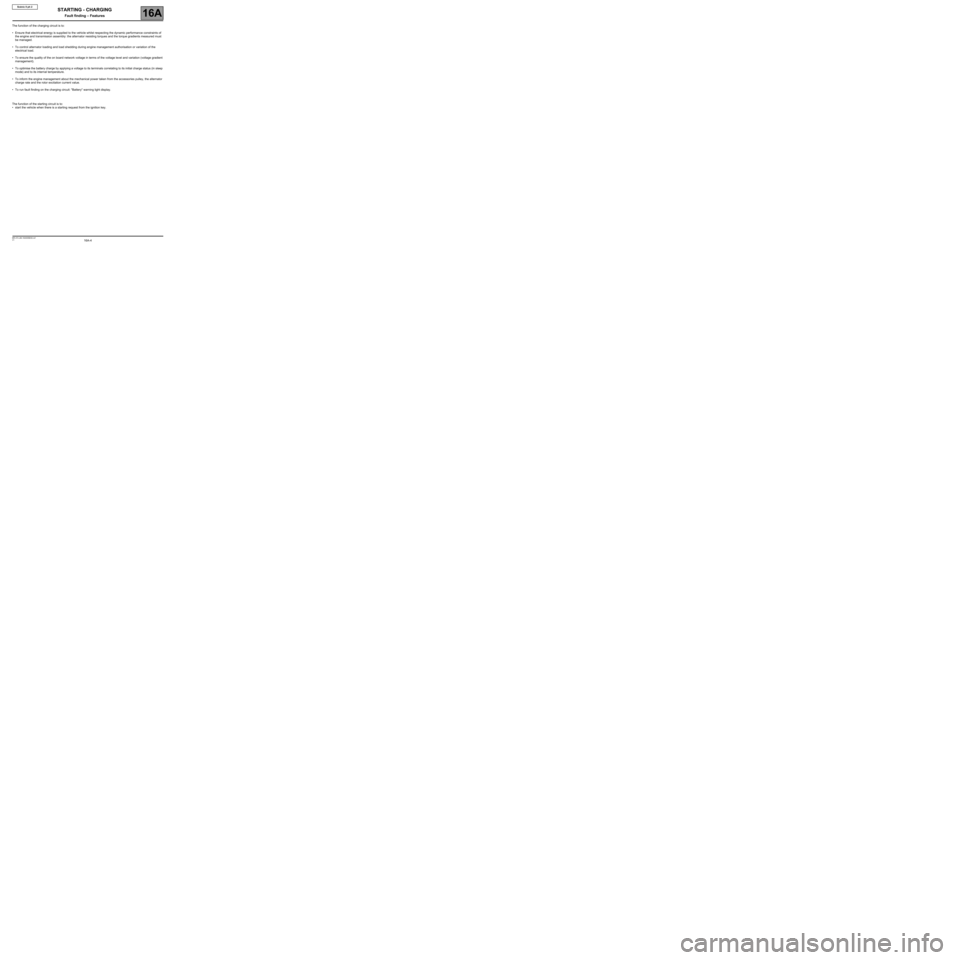
16A-4V1 MR-372-J84-16A000$030.mif
16A
Scénic II ph 2
The function of the charging circuit is to:
•Ensure that electrical energy is supplied to the vehicle whilst respecting the dynamic performance constraints of
the engine and transmission assembly: the alternator resisting torques and the torque gradients measured must
be managed.
•To control alternator loading and load shedding during engine management authorisation or variation of the
electrical load.
•To ensure the quality of the on board network voltage in terms of the voltage level and variation (voltage gradient
management).
•To optimise the battery charge by applying a voltage to its terminals correlating to its initial charge status (in sleep
mode) and to its internal temperature.
•To inform the engine management about the mechanical power taken from the accessories pulley, the alternator
charge rate and the rotor excitation current value.
•To run fault finding on the charging circuit: "Battery" warning light display.
The function of the starting circuit is to:
•start the vehicle when there is a starting request from the ignition key.
STARTING - CHARGING
Fault finding – Features
Page 6 of 21
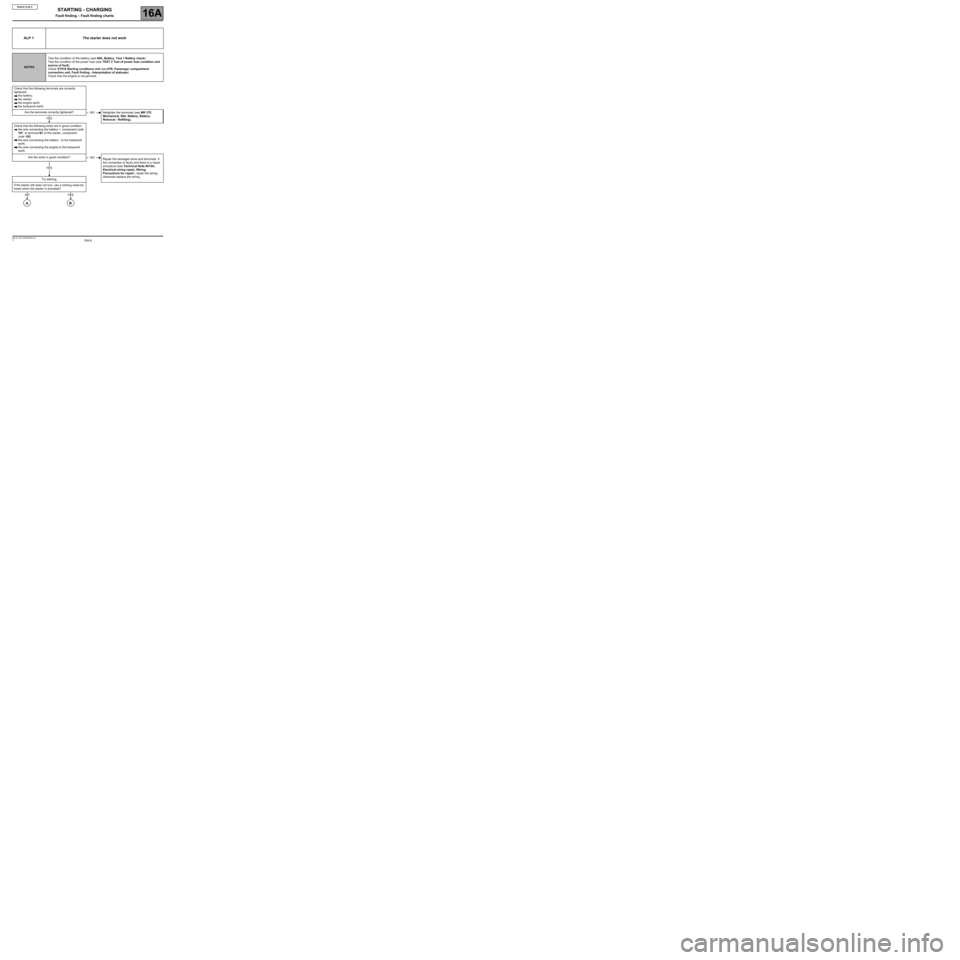
16A-6V1 MR-372-J84-16A000$050.mif
16A
Scénic II ph 2
ALP 1 The starter does not work
NOTESTest the condition of the battery (see 80A, Battery, Test 1 Battery check).
Test the condition of the power fuse (see TEST 2 Test of power fuse condition and
source of fault).
Check ET010 Starting conditions met (see 87B, Passenger compartment
connection unit, Fault finding - Interpretation of statuses).
Check that the engine is not jammed.
Check that the following terminals are correctly
tightened:
the battery,
the starter,
the engine earth,
the bodywork earth.
Are the terminals correctly tightened?
Retighten the terminals (see MR 370,
Mechanical, 80A, Battery, Battery:
Removal - Refitting).
Check that the following wires are in good condition:
the wire connecting the battery +, component code
107, to terminal B+ of the starter, component
code 163,
the wire connecting the battery - to the bodywork
earth,
the wire connecting the engine to the bodywork
earth.
Are the wires in good condition?
Repair the damaged wires and terminals. If
the connection is faulty and there is a repair
procedure (see Technical Note 6015A,
Electrical wiring repair, Wiring:
Precautions for repair), repair the wiring,
otherwise replace the wiring.
Try starting.
If the starter still does not turn, can a clicking noise be
heard when the starter is activated?
NO
YES
NO
YES
A
NO
B
YES
STARTING - CHARGING
Fault finding – Fault finding charts
Page 7 of 21
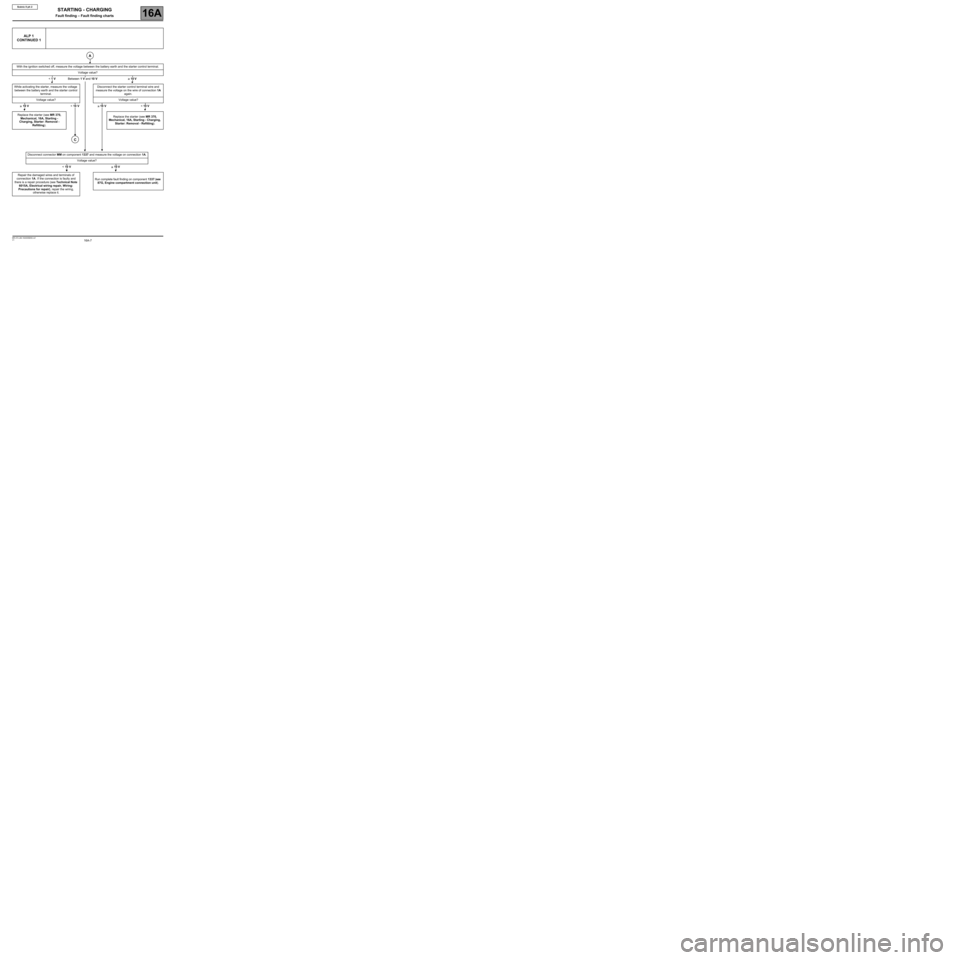
16A-7V1 MR-372-J84-16A000$050.mif
STARTING - CHARGING
Fault finding – Fault finding charts16A
Scénic II ph 2
ALP 1
CONTINUED 1
With the ignition switched off, measure the voltage between the battery earth and the starter control terminal.
Voltage value?
While activating the starter, measure the voltage
between the battery earth and the starter control
terminal.Disconnect the starter control terminal wire and
measure the voltage on the wire of connection 1A
again.
Voltage value? Voltage value?
Replace the starter (see MR 370,
Mechanical, 16A, Starting -
Charging, Starter: Removal -
Refitting).Replace the starter (see MR 370,
Mechanical, 16A, Starting - Charging,
Starter: Removal - Refitting).
Disconnect connector MM on component 1337 and measure the voltage on connection 1A.
Voltage value?
Repair the damaged wires and terminals of
connection 1A. If the connection is faulty and
there is a repair procedure (see Technical Note
6015A, Electrical wiring repair, Wiring:
Precautions for repair), repair the wiring,
otherwise replace it.Run complete fault finding on component 1337 (see
87G, Engine compartment connection unit).
A
< 1 VBetween 1 V and 10 V≥ 10 V
≥ 10 V< 10 V
C
≥ 10 V< 10 V
< 10 V≥ 10 V
Page 8 of 21
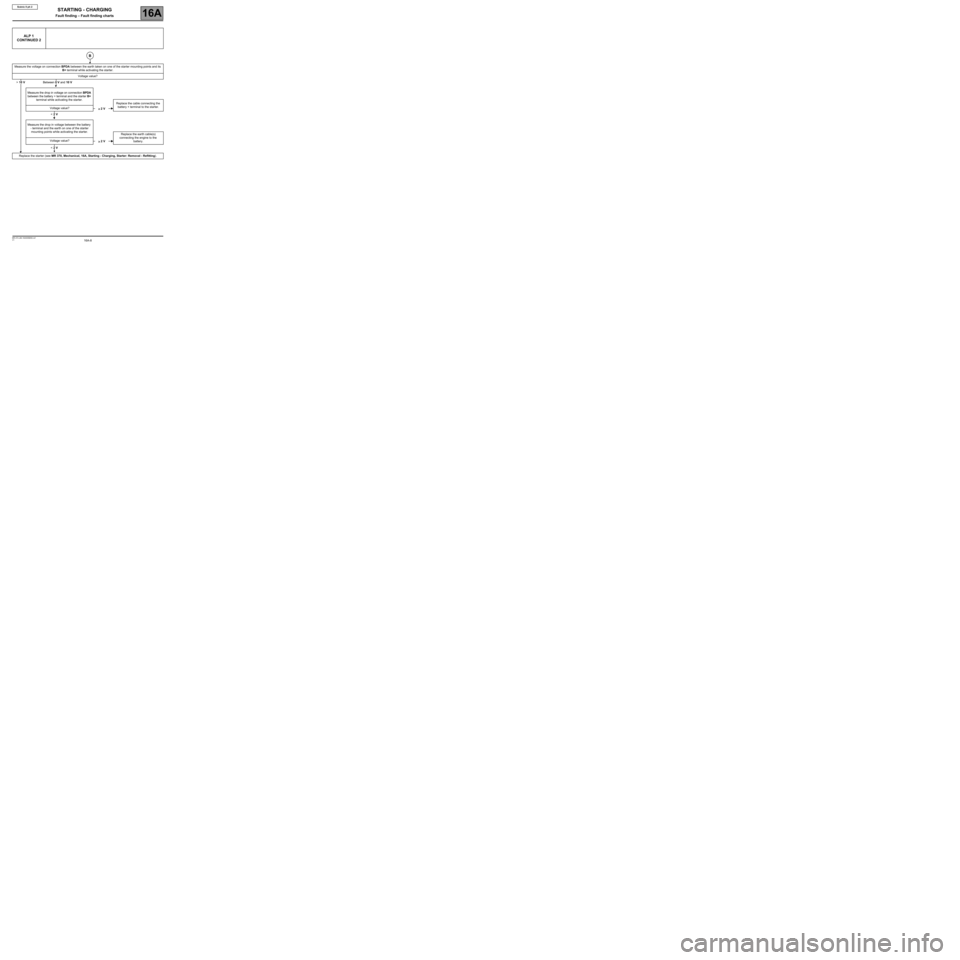
16A-8V1 MR-372-J84-16A000$050.mif
STARTING - CHARGING
Fault finding – Fault finding charts16A
Scénic II ph 2
ALP 1
CONTINUED 2
Measure the voltage on connection BPDA between the earth taken on one of the starter mounting points and its
B+ terminal while activating the starter.
Voltage value?
Measure the drop in voltage on connection BPDA
between the battery + terminal and the starter B+
terminal while activating the starter.
Replace the cable connecting the
battery + terminal to the starter.
Voltage value?
Measure the drop in voltage between the battery
- terminal and the earth on one of the starter
mounting points while activating the starter.
Replace the earth cable(s)
connecting the engine to the
battery. Voltage value?
Replace the starter (see MR 370, Mechanical, 16A, Starting - Charging, Starter: Removal - Refitting).
B
> 10 VBetween 0 V and 10 V
≥ 2 V
< 2 V
≥ 2 V
< 2 V
Page 11 of 21
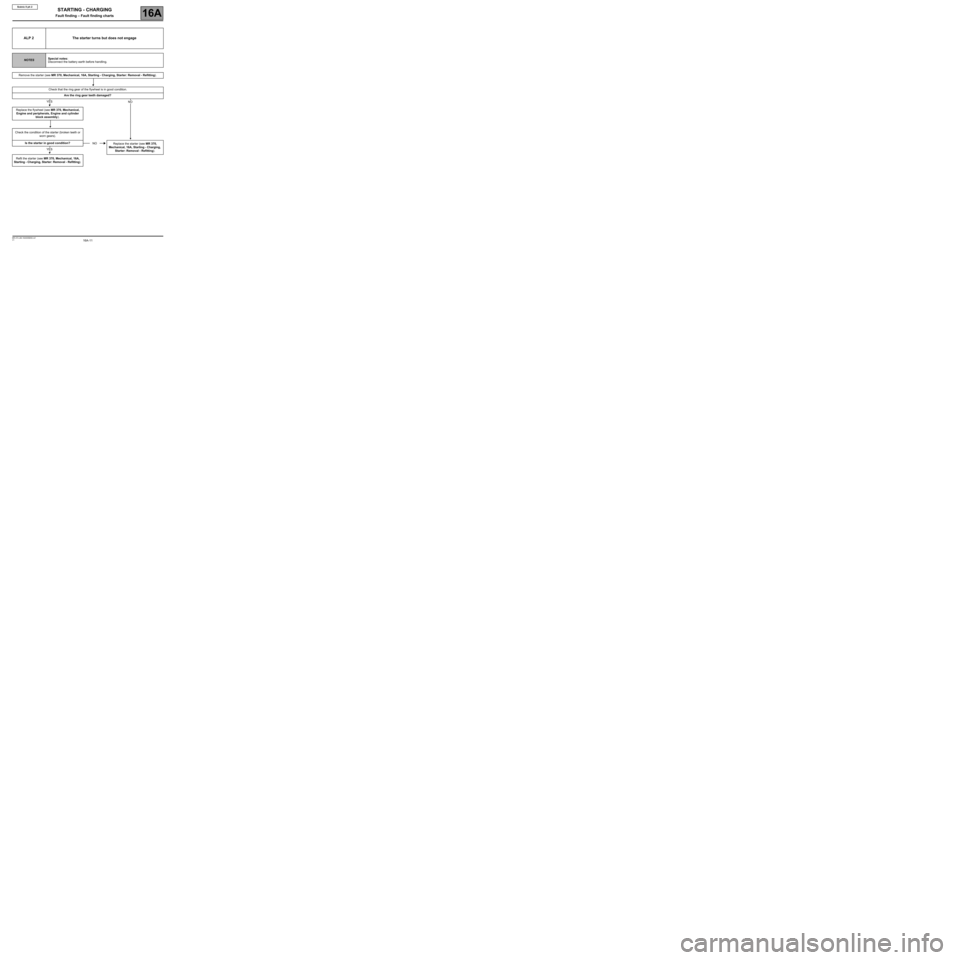
16A-11V1 MR-372-J84-16A000$050.mif
STARTING - CHARGING
Fault finding – Fault finding charts16A
Scénic II ph 2
ALP 2 The starter turns but does not engage
NOTESSpecial notes:
Disconnect the battery earth before handling.
Remove the starter (see MR 370, Mechanical, 16A, Starting - Charging, Starter: Removal - Refitting).
Check that the ring gear of the flywheel is in good condition.
Are the ring gear teeth damaged?
Replace the flywheel (see MR 370, Mechanical,
Engine and peripherals, Engine and cylinder
block assembly).
Check the condition of the starter (broken teeth or
worn gears).
Is the starter in good condition?
Replace the starter (see MR 370,
Mechanical, 16A, Starting - Charging,
Starter: Removal - Refitting).
Refit the starter (see MR 370, Mechanical, 16A,
Starting - Charging, Starter: Removal - Refitting).
YESNO
NO
YES
Page 12 of 21

16A-12V1 MR-372-J84-16A000$050.mif
STARTING - CHARGING
Fault finding – Fault finding charts16A
Scénic II ph 2
ALP 3 The starter is noisy when starting
NOTESTest the condition of the battery (see 80A, Battery, Test 1 Battery check).
Check that the noise is actually coming from the starter.
Try to start the engine.
At what point is the noise heard?
Starting phase Just after the engine has started
Check that the starter is correctly secured.
Is the starter correctly secured?
Tighten the starter mountings (see MR 370,
Mechanical, 16A, Starting - Charging,
Starter: Removal - Refitting).
A
YES
B
NO
Page 13 of 21
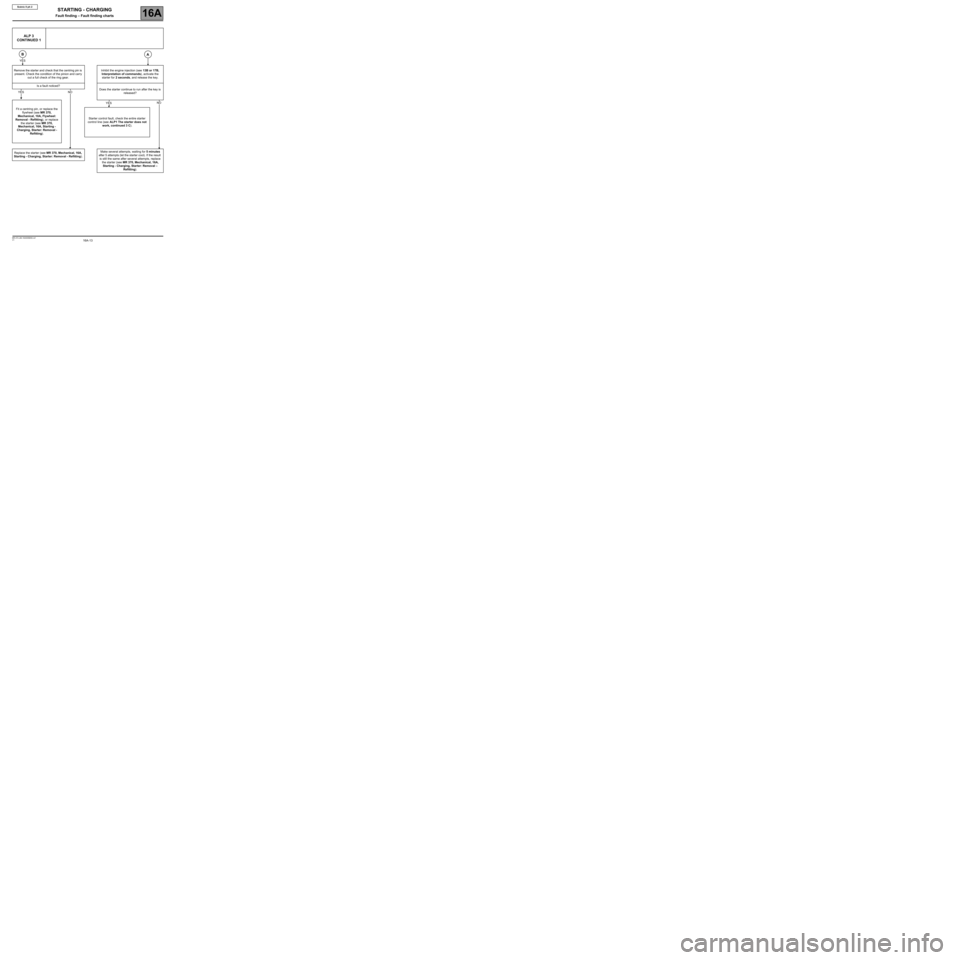
16A-13V1 MR-372-J84-16A000$050.mif
STARTING - CHARGING
Fault finding – Fault finding charts16A
Scénic II ph 2
ALP 3
CONTINUED 1
Remove the starter and check that the centring pin is
present. Check the condition of the pinion and carry
out a full check of the ring gear.Inhibit the engine injection (see 13B or 17B,
Interpretation of commands), activate the
starter for 2 seconds, and release the key.
Is a fault noticed?
Does the starter continue to run after the key is
released?
Fit a centring pin, or replace the
flywheel (see MR 370,
Mechanical, 10A, Flywheel:
Removal - Refitting), or replace
the starter (see MR 370,
Mechanical, 16A, Starting -
Charging, Starter: Removal -
Refitting).Starter control fault, check the entire starter
control line (see ALP1 The starter does not
work, continued 3 C).
Replace the starter (see MR 370, Mechanical, 16A,
Starting - Charging, Starter: Removal - Refitting).Make several attempts, waiting for 5 minutes
after 5 attempts (let the starter cool). If the result
is still the same after several attempts, replace
the starter (see MR 370, Mechanical, 16A,
Starting - Charging, Starter: Removal –
Refitting).
B
YES
A
YESNO
YESNO
Page 15 of 21
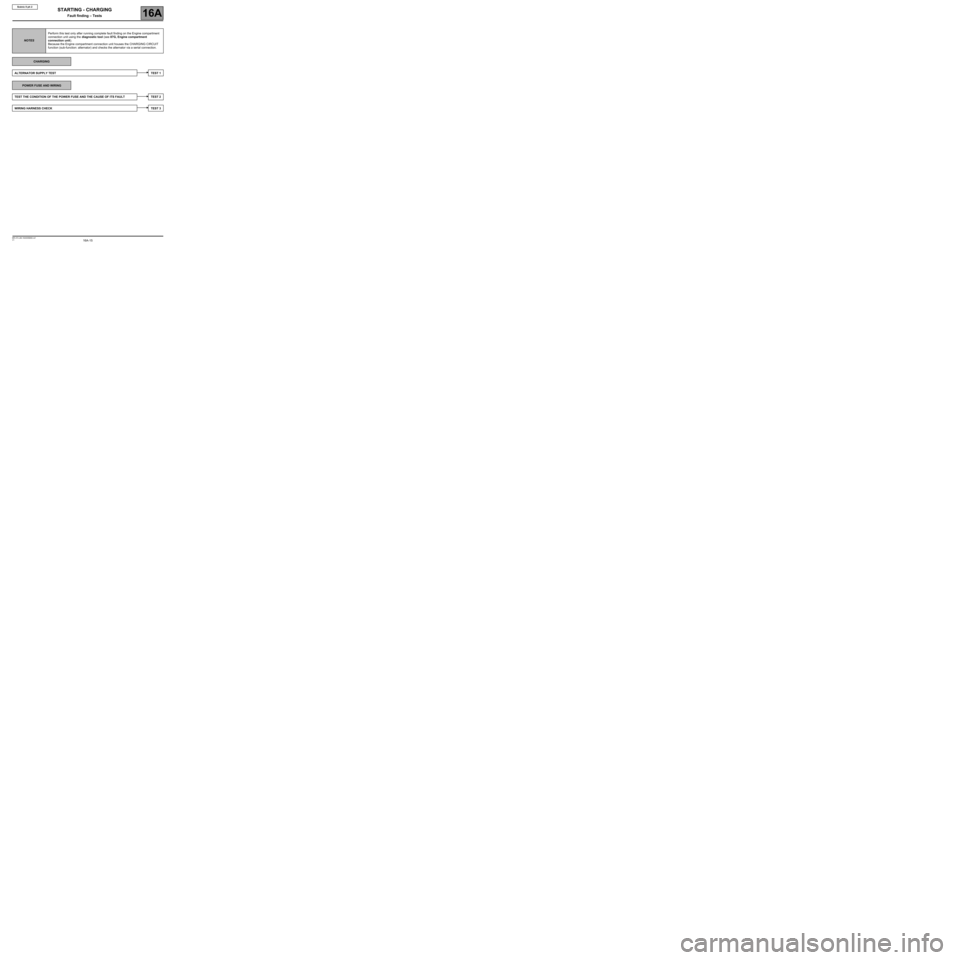
16A-15V1 MR-372-J84-16A000$060.mif
16A
Scénic II ph 2
NOTESPerform this test only after running complete fault finding on the Engine compartment
connection unit using the diagnostic tool (see 87G, Engine compartment
connection unit).
Because the Engine compartment connection unit houses the CHARGING CIRCUIT
function (sub-function: alternator) and checks the alternator via a serial connection.
CHARGING
ALTERNATOR SUPPLY TESTTEST 1
POWER FUSE AND WIRING
TEST THE CONDITION OF THE POWER FUSE AND THE CAUSE OF ITS FAULT TEST 2
WIRING HARNESS CHECKTEST 3
STARTING - CHARGING
Fault finding – Tests